Why would you want to stain wood and what actually is wood stain? You might be bored of the colour. The surface may be damaged or in serious need of a facelift.
Perhaps you’re changing your décor and your wood floors and furniture need to change to match. Maybe your decking needs refinishing.
Whatever your motivation, using a wood stain rich in pigments on bare or stripped-down wood changes the colour and also highlights the lovely grain.
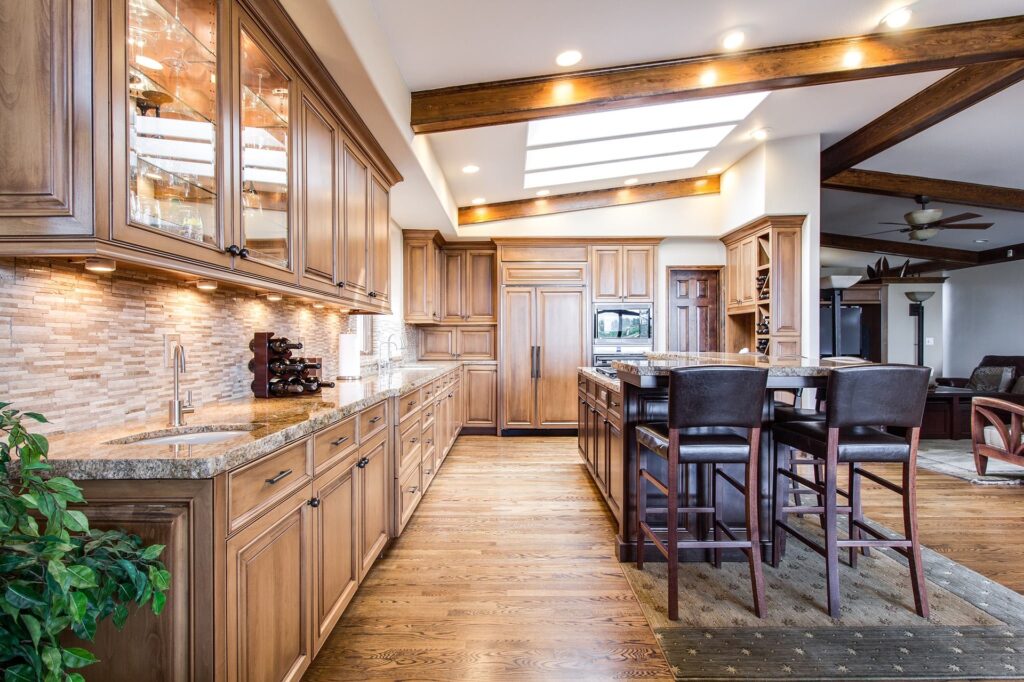
If you’d like our expert advice on this, contact us on 01303 213838 to speak to our dedicated woodcare team. Alternatively, you can always email us at wood@finishes.direct.
You can also join our fast-growing community on Facebook, Instagram, YouTube, Twitter and Pinterest; where we share inspirational photos, how-to videos, whilst giving expert advice.
Why Should You Stain Wood?
Staining Wood is the optimal method for enhancing the look and feel of your wood, it’s a great way to revitalise any interior wooden surface – giving it that subtly fresh feel with a dash of colour.
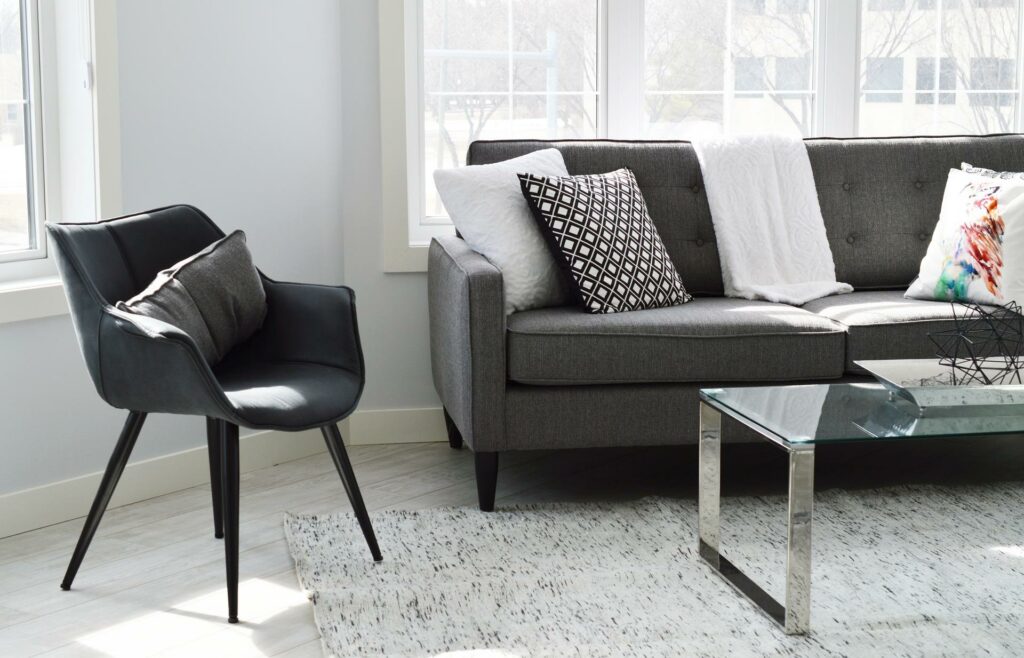
As well as embellishing the complexion of your timber, wood stain also helps preserve the grain of the wood.
If any of your furniture, floors or even decking (more on that later) are looking worn, harnessing the range of colours available with stains can go a long way to impressing your family or friends at a modest price point.
What Wood Can You Stain?
Well, any wood – nothing’s off limits. It’s more common to stain interior wood, so if you’re looking into that – we’d definitely recommend you do this.
Stain is thinner than paint and doesn’t mask the visual appeal of wood, which is why it’s a popular option on interior timber; it prevents your wood from losing its visually appealing aesthetic, which is probably why you bought it in the first place.
Although there are still some things to consider when choosing the perfect stain for you. Dark wood won’t work well with light and bright stains, your best bet with dark timber is to pick a wood stain that is also dark.
Otherwise, your dark timber will manipulate how the brightly coloured stain looks and won’t look how you anticipated.
However, you can stain all sorts of exterior wood too, such as your wooden garden furniture.
There are some wood stains on the market that can be used on decking too, such as Cuprinol Anti-Slip Decking Stain.
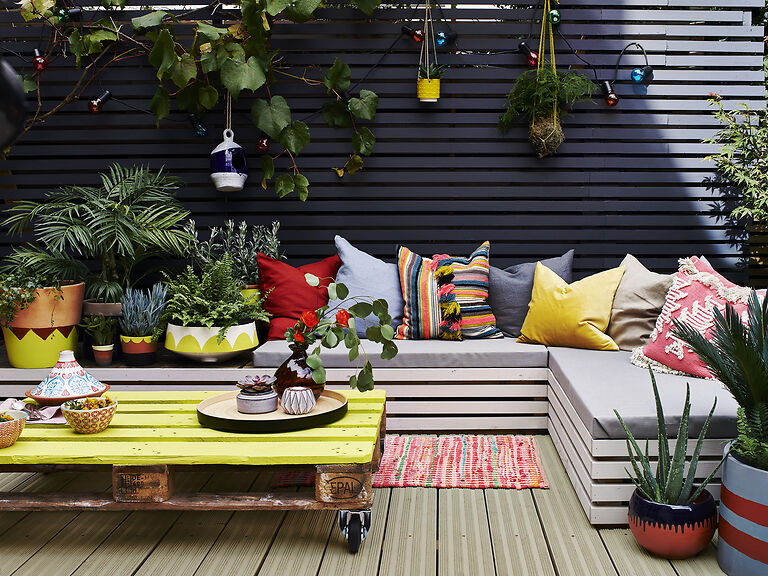
However, it’s important to note that wood stains don’t offer great protection against weathering, foot traffic and just about every other potential misfortune your timber might have to go head-to-head with.
So, we would thoroughly recommend applying a preserver underneath your wood stain top coat, take a look at our Top 5 Decking Preserver Product Guide for more expert advice.
What Type of Wood Do You Have?
Before you go anywhere near an interior wood stain, deck stain or just about any other stain, you need to know what type of wood you’re dealing with.
Is it a softwood or hardwood? They behave differently, and the application process and end results are different.
How do you tell them apart? Softwoods include pines, firs and cedars. Hardwoods include oak, walnut and birch.

In between you have a few oddities. Box, for example, is a surprisingly soft hardwood and fir is a very hard softwood.
The long and complicated list doesn’t stop there, though. There are thousands of tree species and within each species there’s dozens of variations.
In short, no two trees are the same – be mindful of that when trying to get your desired finish.
Softwoods tend to have an uneven grain, often with patterns or blotches, and in some cases can stain unevenly.
You might want the grain to stand out from the background and dye darker, since it’s a great way to enhance the wood’s beauty.
If not, you could try a special pre-stain conditioner which sinks into the wood fibres to give an even base.
Wood conditioners are bigger in the US and have mixed reviews. Manns Classic Pine Stain is specially formulated for pine and other soft grain woods. Manns also make a range of wood stains for hardwoods.
Hardwoods tend to have a neat, even, finer grain. You can use any stain you like on hardwoods, but you may need multiple coats to achieve the same effect as you get on softwoods.
Hardwoods are also generally stronger and are more durable than its softer counter-part. For interior hardwoods, we suggest you take a look at Manns’ Classic Oak Stain.
Types of Wood Stain
Wood stains are designed to penetrate the wood rather than sitting on top it, this is what helps give your timber that natural look and feel post staining.
There are two types of formula’s in the wood staining world that you need to be aware of, water-based and solvent-based stains – each with positives and negatives.
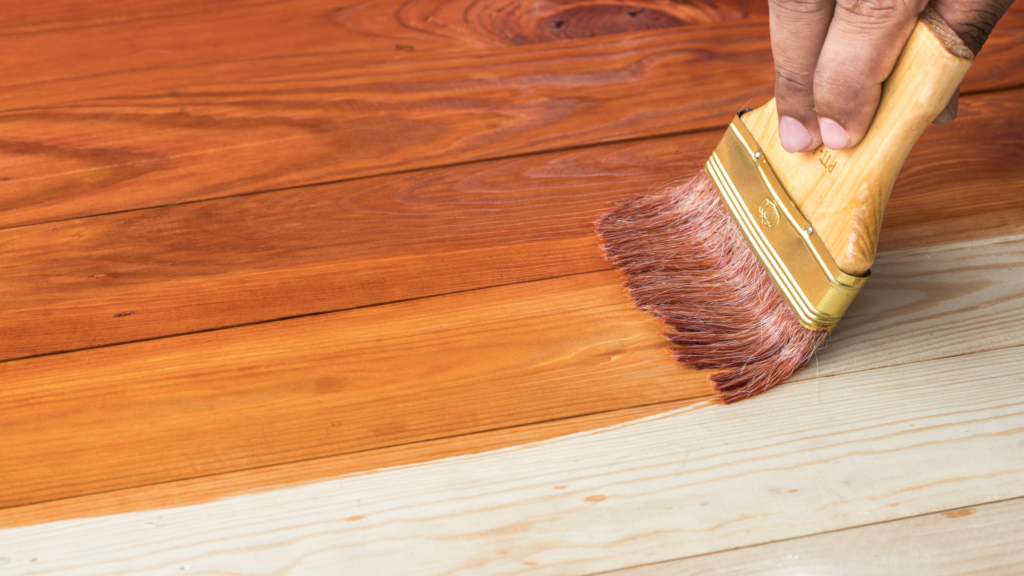
Water-based
Water-based wood stains deliver an even colour and won’t absorb unevenly; they smell less and dry faster, usually within a couple of hours.
You can clean with ordinary soap and water instead of solvents, you also get a broader colour range. It’s best to apply water-based products with a synthetic brush.
There are plenty of positives and negatives to water-based stains. One of the big positives is that it is environmentally friendly, as it is nearly entirely made up from water.
Of course, this is also a drawback in protection and effectiveness, as water doesn’t have many protective or visually appealing properties.
Water-based products typically contain a low or minimal V.O.C, which stands for volatile organic compounds. The lower the V.O.C, the less nasty smelling toxins and chemicals in your stain.
If you’re looking to spruce up your hardwood floors, take a look at Manns Classic Oak Stain.
This stain is rated with a very low V.O.C, comes in over 15 colours and is available in sample pots. So you can be 100% certain you’ve got the perfect colour for your timber.
Once you’ve used the handy test pot, use the Wood Finishes Direct Calculator to work out just how much is needed to avoid wastage.
Solvent-Based
Solvent-based wood stains, such as Morrells Light Fast Wood Stains are commonly used by professionals.
This is because they are fast drying as this stain only taking 30 minutes to completely dry and is easy to apply.
They are also ‘Light Fast‘, meaning that they are fade resistant, making them perfect for areas that are exposed to direct sunlight.
Solvent-based wood stains typically reach the higher end of the spectrum in regards to V.O.C’s.
There are several precautions you should take when handling any type of stain regardless of its V.O.C. However, take extra measures when using high V.O.C products, especially indoors.
This is due to the fact that they have a much stronger smell and can affect the air quality.
If high V.O.C’s already affect you such as petrol, we’d suggest you look at the water-based alternative if you’re a budding DIY’er.
A popular exterior use solvent-based wood stain is Sadolin Extra Durable Wood Stain. This contains pigmented (coloured) varnishes that are ideal for softwood and hardwood projects, including doors and windows, for extra long-lasting protection.
It doesn’t have the most varied colour range in the world, but delivers quality finishes and enhances your woods final look.
Before You Start Staining Tips
Every piece of wood is different. Every tree is unique, even within the same species.
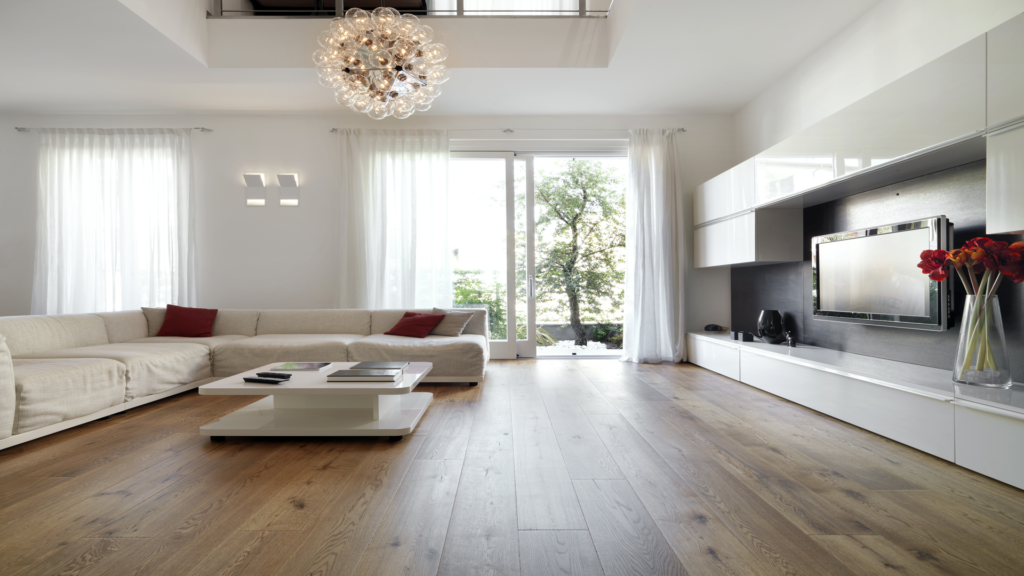
So our first tip is this: Always do a test area first.
Make sure to trial your interior or exterior wood stain product on a small, hidden area of wood to make sure things aren’t going to go pear-shaped and you end up with an inadequate finish.
Our second tip is: Remember your wood stains act the same way to wood as a pair of sunglasses would to you.
Your exterior stain for example will add an extra layer of UV protection every time you apply one. However the more you add, the darker your wood gets.
If you keep adding stain layers, eventually you won’t be able to see the wood. If that was your sunglasses you wouldn’t be able to see anything, find the perfect balance for protection and visibility.
How to Stain Wood in 8 Simple Steps
1. First, remove any dust, stickiness, polish, wax, paint, grease or dirt by either sanding, using a wax and polish remover or a paint and varnish remover. White Spirit and Methylated Spirit are also great de-greasers and wood cleaners.
If you’re cleaning your decking and a stiff brush isn’t cutting it, take a look at Ronseal’s Decking Cleaner and Reviver.
This product is perfect to use alongside their Ultimate Finish Decking Pad Kit, for an easy application and extra pad to apply your stain with. For more information, take a look at How To Stain Decking for a Flawless Finish.
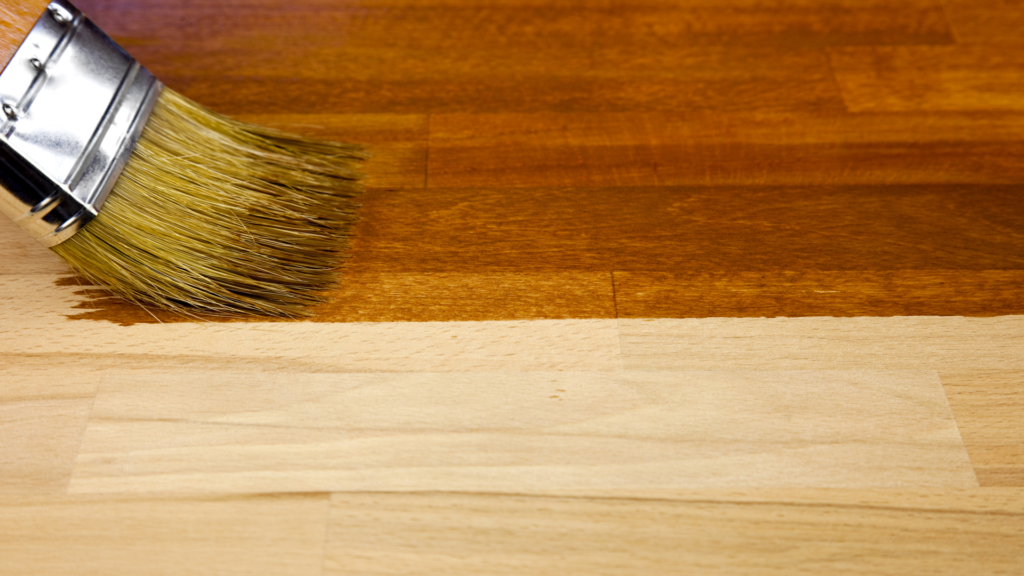
2. Next, sand the old surface to provide a clean, fresh surface for your wood staining product.
You might need to resort to coarse paper then work your way up to finer (120 – 150 Grit) sandpaper to finish, or dive straight in with a light paper when there’s less preparation to do.
This is a vital stage because wood stains won’t give an even result if the surface is mucky.
If you leave the surface too rough, it will absorb more stain and give a darker finish and the smoother the finish, the lighter the colour. Experiment on scrap wood or a small area on the real thing first.
3. Wipe down your beautifully sanded surface with a damp cloth to remove any debris.
4. Put on your rubber gloves and stir the wood stain thoroughly. The colour pigments are usually heavier than the solvent or water carrier so tend to be more concentrated at the bottom of the tin or container.
Make sure to stir the wood stain periodically during the application process, especially after breaks to ensure a more consistent finish.
5. Follow the manufacturer’s instructions on the tin or container to the letter, applying the stain with either a sponge, brush or lint free cloth.
6. Use smooth, continuous movements, following the grain rather than working against it and applying the wood colour evenly.
7. Leave it to dry according to the instructions. As a general rule, the longer you leave it, the darker the tone.
You can always wipe small areas off and put back after you’ve checked on the progress. Bear in mind it’s much easier to apply more stain rather than try to remove it because you’ve gone too far.
Always remember to never rush between coats, doing this risks completely destroying your wood – there’s no point rushing the easy waiting stage.
8. When you’ve achieved the right depth of colour leave it to dry again, as per the instructions.
Expert Advice
“Take care when sanding wood. Wood that has been sanded evenly will produce an even colour. Poorly sanded wood is likely to produce a more patchy, uneven finish”
Wood Stains and their Colours
The beauty of coloured wood stain is the sheer variety of shades and tones. Everything from clean, crisp white wood stain for contemporary living and working spaces to subtle grey wood stain, dramatic black wood stain and a multitude of other beautiful wood stain colours.
We stock a vast range of coloured wood stains, including the glorious Osmo Country Colour.
Which is available in opaque, satin-matt and a host of beautiful shades including blues, greens, greys, reds, oranges and more.
But, just be careful when staining a lighter wood species, such as pine. As using the incorrect product can cause your wood to darken way beyond what you wanted.
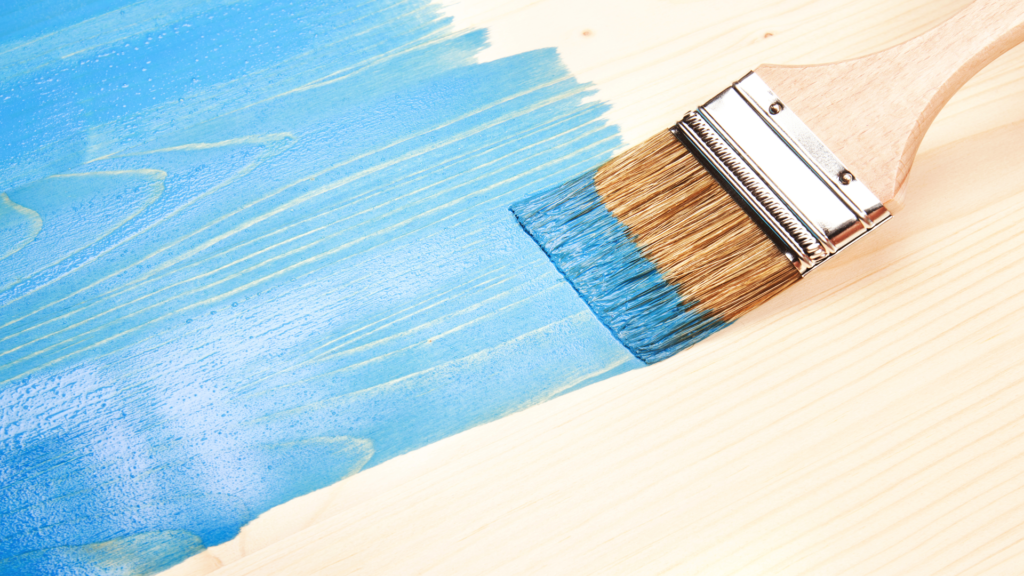
Luckily, there is a vast range of products specifically designed to work its magic on your lighter coloured wood to enhance its beauty – rather than destroy it.
A reason for these specifically designed stains being so successful is because they contain a very small amount of white pigment, which in-turn helps retain the natural finish and feel of your wood.
A great option for this is Manns’ Classic Pine Stain, this water-based interior stain comes in over 25 colours, which helps tailor the product to your desired look.
However, we wouldn’t recommend using these types of products on dark woods as they can leave the timber with a milky appearance.
For a detailed and in-depth guide on wood colour, check our Essential Guide to Wood Colour article, running your through every detail of how colour actually affects your wood – filled to the brim with our bank of knowledge.
The table shows a varied selection of wood stains and their features, to help give some guidance towards the best stain for you.
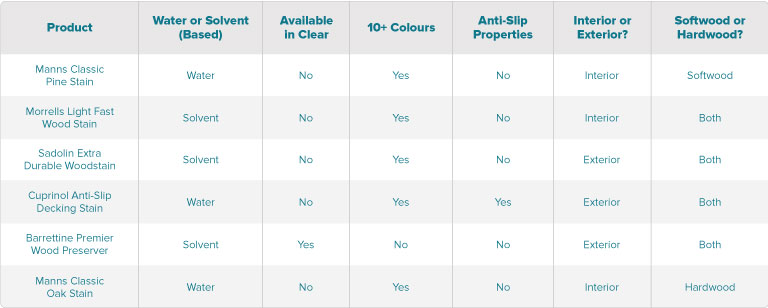
Expert Advice
“Ignore the names given to colour names and go by the visual appeal of the wood colour. Compare a medium oak colour swatch from 6 different companies and I’m pretty certain that they will all be different”
Wood stain dos and don’ts
How do you remove coloured wood stains? This very much depends on the type of wood being stained and the stain used. If it’s purely a water-based stain that has been freshly applied, then Woodleys Wood Stain Remover is your first stop.
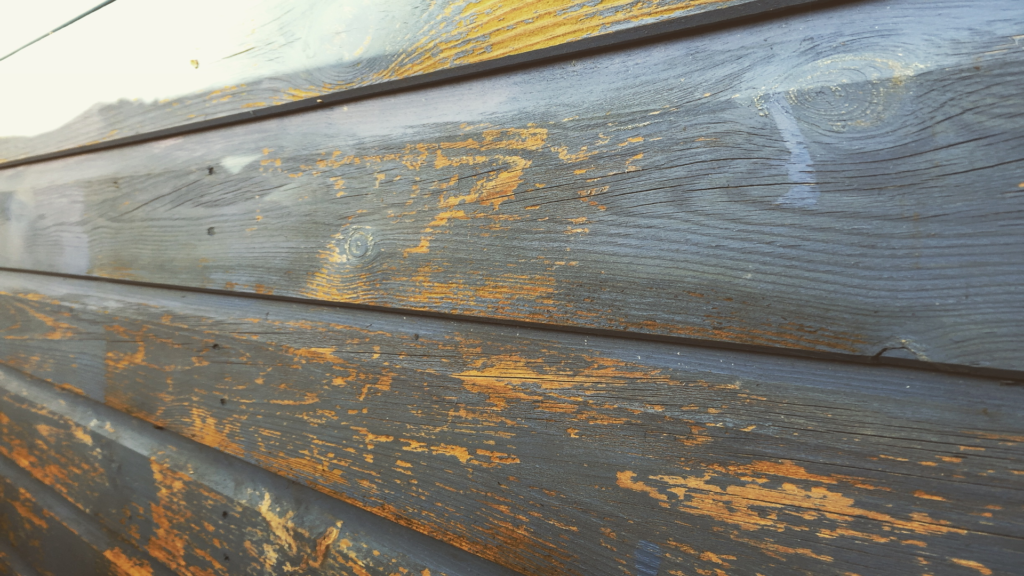
Spirit-based wood stains should be removed by scrubbing with cellulose thinners, methylated spirit or white spirit.
It can be tricky to fully remove a stain and it may be necessary to sand the wood back if the removal process doesn’t fully work.
Many shop-bought wood stains contain a stain and sealer (type of varnish) as an ‘all-in-one’ product. The only way to remove these is by sanding the wood back.
Stainable wood fillers are available but many ‘off the shelf’ fillers will not accept a stain.
Fillers that have been specifically designed to be stainable can often be over-coated with wood oils and varnishes.
Although these fillers will take a stain, the final colour may still differ from the surrounding wood, so it’s important to do test areas and comparisons before starting the main project.
Osmo Interior Wood Filler is a popular choice among DIYers. The water-based filler is ideal for interior restoration and renovation projects.
Dos
Always use the best quality products you can afford, for the best durability and finish.
Take care when applying a water-based varnish over a water-based stain. A solvent-based finish over a solvent-based stain or an oil-based finish over an oil-based stain.
This is because if the first coat of the finish isn’t applied gently, it can re-activate the stain and drag the colour. Which results in an uneven colour and patchy finish.
For example, using a solvent-based varnish over a water-based stain, or a water-based varnish over a solvent-based stain, this isn’t a problem.
Don’ts
Never leave hinges, handles, knobs or pulls on, since wood finishing products can change the colour of the metal.
Don’t let un-absorbed stain sit on the wood for any length of time. It’ll only peel off and won’t give you a darker finish.
Never apply a finish before the stain is completely dry. The solvents will damage the stain’s finish.
Staining Your Decking?
If you’re staining your decking and need a bit more information before tackling the mountainous task, take quick read of our How To Stain Decking for a Flawless Finish article.
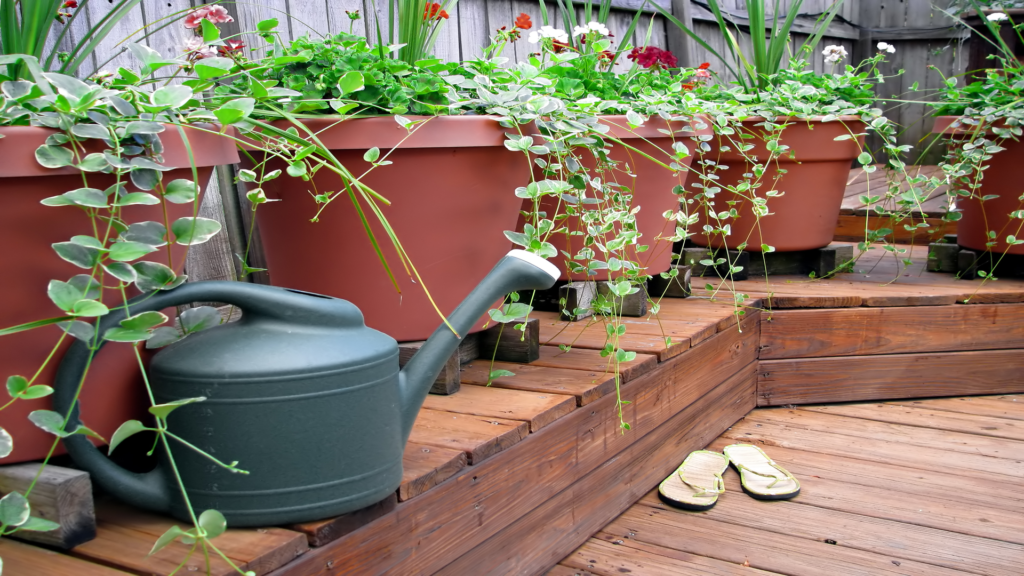
Giving you a step-by-step guide, with product recommendations and our usual expert advice.
You can also check out our Common Mistakes to Avoid When Staining Your Decking article.
Which goes through all the regular slipups made when staining your garden timber, so you can take on the challenge like a professional.
Aftercare
The aftercare is fairly straightforward, but make sure to check the product information first in-case there is any specific aftercare requirements for the stain you’ve purchased.
Just make sure you regularly clean whatever wood you have stained. If it’s decking you’ve been staining though, a suitable decking cleaner will help get you back on track rather than deck stain in most cases – unless it’s in a really sorry state.
We’d love to hear from you
For more information and advice, feel free to contact our dedicated support team at 01303 213838 or email us at wood@finishes.direct.
Join our fast-growing community on Facebook, Instagram, YouTube, Twitter and Pinterest; where we share inspirational photos, how-to videos, whilst giving expert advice.
A guest post by Kate Goldstone


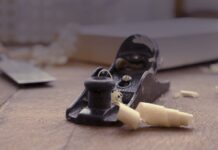


Hi – if I have applied a solvent based stain – morells – can I apply an oil based wax finish like osmo or do I need to varnish?
Good Afternoon,
Thank you for your question, I would say that yes you are able to use a solvent based oil over the top, should a test area prove positive. Care should be taken if brush, roller, sponge or pad applying a solvent based top coat over this product as lifting or dragging of the solvent stain can occur, so I would recommend allowing a couple of hours for the stain to dry before trying the oil top coat. This is not an issue if over-coating with a water based varnish / lacquer or wax. Allow the test area a 48 hour drying period and carry out a scratch test to ensure the oil has penetrated the woods surface and been able to cure effectively.
For the best result however a Morrells wood lacquer will be the best option, for more advice please feel free to get in touch via our contact us page.
Kind Regards Samantha.
Hi. I’ve recently bought a 1960s golden teak sideboard. My problem is that it looks orange in my sitting room. Added to this, my current furniture is mostly mid-brown, and the teak sideboard just looks wrong. I want to keep it, as it’s a lovely solid wood piece, but the colour looks terrible. Can I apply a stain over oiled teak, and can I produce a mid to dark brown colour without affecting its lovely grain?
Many thanks,
Penelope
Hello Penelope,
Thank you for getting in touch. If it is currently oiled then you can only apply and oil or perhaps a wax. The oil is dependent on how saturated the wood currently is but as a guide if the oil was applied within the last 2 – 3 years on a teak substrate it is unlikely to take further oil at this time. If the oil Older then you could consider a fresh coat after the right preparation.
Alternatively you could look at a coloured wax such as the Fiddes Supreme Wax Polish this could add lustre and colour to the sideboard and still leave it looking very natural.
I hope that helps and please do not hesitate to get in touch via our contact us page for further advice.
Kind Regards Samantha.
Hello, I was wondering if you could advise me on best route/products? I have painted newly laid deck boards with a water based decking stain with two coats as instructed. However, it is already showing signs of wear from my dogs claws and comes off with cleaning. I am hoping to re-coat and then cover with an oil based varnish. Store assistants have not been able to offer advice so far. Thanks in advance
Good Afternoon Angela,
Would you be able to email me with details of which product you have used? And when it was applied? And then I can advice you moving forward on how to treat your decking. contact us page.
I look forward to hearing from you via our contact us page.
Kind regards Samantha.
Hi I wonder if you can offer some advise please. I recently sanded back to bare wood my pine dining table top, I then coloured it with Colron Refined Beeswax in antique pine. Firstly I am disappointed in the colour as it a little too orange for my liking and secondly I now find I’m getting colour transfer i.e if you lean on the table you stain your elbows! Can you suggest how I may tone down the orange and then seal the wood to stop the colour transfer.
Many thanks
Tanya
Good Afternoon Tanya,
You will often find that the natural tones of the wood are highlighted when a finish is applied and with Pine, this can be orange, yellow or pink. Although Waxes will not have that much impact on the colour but the combination of the colour in the wax and the natural tones of the wood may be what is causing that finish. Wax does not dry hard either, it can help to protect the wood and is a traditional treatment but it does not cure to a solid finish and this is why you are getting some rubbing off.
For a more durable and long lasting finish that dries hard you could look at a Hard Wax Oil such as the Fiddes Hard Wax Oil you would need to remove all the current wax finish however as this will prevent penetration of the oil into the surface of the wood.
We have some great videos on our You Tube Channel >>> https://www.youtube.com/channel/UC7-tgwbsUxm73aVnAjLGHRA?view_as=subscriber that will help with product advice and if you have any further questions please do not hesitate to get back in touch via our contact us page.
Kind Regards Samantha.
Hello, I wonder whether you might be able to help. I really like timber kitchen worktops, but have bought kitchen units that are a soft taupe colour. With this it seems neither redish nor yellow wood tones work. The woods that appeal in terms of their properties are either new oak or reclaimed iroko worktops. The aim would be to get these to be lighter and white or grey tone (it is a small room!).
Are there any products that you can recommend for firstly bleaching (oak or iroko) and then staining (oak or iroko) in that direction?
I appreciate that I will need to try this out, but I don’t know where to start with products and you seem to carry a big range. In the past i have used OSMO tints and polyx oil, but this was for pine floorboards, and I suppose food safety is an issue with worktops.
Many thanks for your consideration.
Good Morning Arija,
My apologies for the delay in getting back to you. My advice for you would be to get a lighter wood, it you want to get a good white or grey tone to the wood then Iroko is not the wood to go for, oak you could get away with but a pale oak is best. It is easy to add colour to wood to darken and colour it but not so easy to lighten it and it will be far easier to get a lighter wood than it will be to try to bleach it to the desired colour.
Osmo oils are great for white or pale finishes and we have a great Blog Beautiful White Wood for Dreamy Interiors which has great tips on how to achieve a range of white finishes using oils. And all the Osmo Oils are food safe and suitable for use on worktops.
I would be happy to advice further if you would like to get in touch via our contact us page.
All the Best Samantha.
can I stain a pine handrail with mahogany polish ?
Good Afternoon Ron,
Polish can be used on a range of surfaces including bare wood and lacquered. Colour will depend on the natural colour of the wood you are applying it to or any treatment that is already on there and test areas are always recommended to ensure you have the right product for your project and the colour is as desired.
For further advice please feel free to call in and speak to one of our Wood Wizards on 01303 213 838.
All the Best Samantha.
Hi. (Great site!). I wish to re-coat my exterior west-facing softwood banister with as hard a wearing stain as possible. The rail has been worn (& now sanded) back to bare wood but the posts are mostly still an old mid (oak?) brown. Happy to have a lighter coloured rail but not too worried about actual colour, more concerned about minimal maintenance (wanted to replace it with brushed stainless steel but my wife would not let me!) going forward.
Any ideas please?
Cheers, Nick
Good Afternoon Nick,
You could have a look at the Sikkens Cetol Novatech and Sikkens Cetol Novatop-this combination could give a very durable and long lasting finish. If well maintained it can last for a few years before requiring a top up or new treatment.
If you take a look at the products and read all the information and if you have any further questions please do let me know. Always try a test area first.
Kind regards Samantha.
Dear Samantha
I have a Rosewood wardrobe that has been sitting in a damp shed for over a year now, and the wood is looking a bit worse for wear with some mould starting to show. The wardrobe was also damaged during a removal. I’m going to sand it all down, but was wondering if you could recommend a product which will bring it back to life?
I look forward to hearing from you
Kind regards
Bruce
Hi Bruce,
Is the Wardrobe bare wood or finished with a wax, oil or varnish?
It may be necessary to treat the mould with a mould and mildew remover such as Barrettine Mould and Mildew Spray. This will not only remove existing mould but will also kill off any mould spores in the grain of the wood to prevent it coming back.
In terms of restoring the wardrobe once it has been sanded down depends on what type of finish you prefer. There are a wide range of oils, waxes, varnishes and stains that can be used. Feel free to contact are resident experts who will be happy to discuss this project and make some recommendations based on the desired look and finish required.
I hope the above helps.
Kind regards,
Nick.
can you advise me how to get brush & grain on to white doors and skirting boards the builders did it s a new house ?
Hello Beverley,
Thank you for your enquiry, if you can email me with details of what is currently on the doors and skirting an what look you are hoping to achieve as well as the type of wood you are applying to, I may be able to narrow down some options for you, please get in touch via our contact us page.
Kind Regards Samantha.
Hello, and thanks for this blog page.
I’m new to woodworking, and largely self-taught through online videos. Many of these are American, and some of their terminology or available products are different – stain being a big one!
Almost every wood staining video (just like the one above) shows an oil-based stain being liberally applied, left a few minutes and then the excess wiped down. These then require a finish topcoat. However, all the stain I see in shops in the UK is some kind of exterior wood product that incorporates varnish, promises protection from the elements and doesn’t look like it would easily take a topcoat or be easily wiped off in the same way.
You seem to imply you stock stains of the common American type – intended for their colour much more than their protection, and that can be applied as in the above video. Can you suggest which products this refers to please?
(The finish I’m trying to recreate is an antique dark oak which has a base yellow/amber dye, followed by a dark brown stain, then a topcoat.)
Good AFternoon Tom,
Thank you for getting in touch with your enquiry. For water based stains you could have a look at the Manns Classic Pine Stain or Manns Classic Oak Stain these are versatile to use and can be intermixed or lightened by adding water. They can be applied in a number of coats, and can raise the grain, light sanding with a finishing pad or high grit sand paper will help.
Alternatively the Light Fast Wood Stain give a more intense colour and because they are a solvent based stain will not raise the grain.
The wood that you are applying to will impact on the colour that will be achieved and so test areas will be vital to ensuring that you get the colour you want. All these recommended stains require a top coat product for protection and I am happy to advice further on this if you should wish to email me with details of you project and requirements.
I hope that helps and feel free to get back to me if you have any further questions.
Kind regards Samantha.
Hi Sam,
I am completely bewildered by all the choice, and I hope you can help me out! I have just had two floating shelves in sanded, but otherwise unfinished American oak delivered. I need to make them a light-mid grey colour with wood grain still visible and a matt, or very nearly matt, finish. They are intended for bathroom use and will have the washbasins sitting on the top. As such will definitely get some water or soapy water splashed on them.
From the reading I’ve done it looks as though an oil based stain is the way to go, but please help out – once they are in place it will be difficult to do any further work on them, so the finish needs to work for years with low maintenance other than normal wiping down. Is there anything you can suggest?
Thanks very much
Damian
Good afternoon Damien,
Apologies for the delay in getting back to you. One product you could consider is the Osmo Wood Wax Finish Transparent. This is a coloured oil that will protect the wood, making it moisture resistant. There are a couple of grey tones in this range and two thin coats will give a natural finish that allows the grain to show through.
Using the right type of cleaner will help to prolong the life of the oil, normal household cleaners can damage or strip the oil over time.
If you take a look at the oil and feel free to come back to me if you have any further questions, and always try a test area first as the wood that you are applying to will have an impact on the finish achieved.
All the Best Samantha.
Hi
I have just bought a small light Beech coloured table for our dining room. Is it possible to stain it with a light oak colour to blend in with the other pieces of furniture in the room?
Kind regards
Charlie
Good morning Charlie,
You could have a look at the Manns Classic Oak Stain. This is a water-based stain that is very versatile. It can be intermixed to give a new colour or lightened by adding water or even applied in a number of coats to intensify the colour. The stain is available in sample sizes and test areas will be important as the wood that you are apply it to will have an impact on the colour that will be achieved.
Once you have the colour that you want then a top coat product for protection can be considered and depending on your preference you could look at a Varnish or Hard Wax Oil.
I hope that helps and if you have any further questions please do not hesitate to get in touch.
All the Best Samantha.
Great website, very helpful. What is the best product to lighten mahogany hardwood flooring after sanding? And what is the durable hard wearing varnish or finishing product after that? Have you ever lightened Brazillian mahogany flooring before? Thank you.
Hello Diana,
Its can be very difficult to lighten the natural colour of wood, other than by bleaching it and this is a complex process of which my knowledge is very limited. Applying a light stain will simply maintain the colour that is already on there or even darken it slightly. You may want to speak to a floor finishing specialist or perhaps reconsider the finish that you would like to achieve.
If there is anything further that I can help with please do not hesitate to get in touch.
Kind regards Samantha.
Another question please: inserting the new planks have left @2-3mm gaps between some of the planks. What is the best way to fill the gaps please?
Thanks
Hello Sam,
For Gaps between floor boards you could have a look at the Bona Gap Master. It is a flexible filler idea for this type of gap. And can be sanded and over coated once dry. Always try a test area first.
Kind regards Samantha.
Hi
I have a wooden floor which has had some planks replaced in one area (due to damp). The whole floor has been sanded but my problem is how to get the colour of the new planks to the same shade of the rest of the room before I stain them. Any advice would be appreciated!
Hello Sam,
Colour matching new floor boards with old can be difficult but not impossible. As a starting point the Manns Classic Pine Stain. There is a wide range of colours available and it is very versatile, you can intermix to create new colours or add water to lighten the tone. You can also apply a number of coats to intensify the colour. So this could be a good product for bringing the boards to a close match.
Once you have the desired colour you can then apply a top coat product such as a Varnish or Hard Wax Oil to give protection to the wood. Test areas are key with your project to get the finish that you want. I will be happy to take a look at some photos, if you could send them in via our contact us page.
Kind regards Samantha.
A general question, hoping to draw on your experience.
I am planning to make up some picture frames, and the same profiles are available in a variety of woods. The least expensive, other than pine, are – in ascending order – ayous, ash, and steamed beech.
Of these, which is likely to stain most easily and evenly?
My idea at the moment is to use fairly bright/strong Mixol colours in whatever medium might work best – your recommendations for any particular wood would be very welcome. The finish I hope to achieve in the end is a low gloss/lustre.
I do understand that I should do some testing/experimenting for myself, but with so many variables, I’d like to start with the most promising possibilities.
Thanks for any advice you can offer.
Hello Richard,
Thank you for your enquiry, am not familiar with the Mixol Range and so its difficult to fully advice, however I can tell you that of the three woods you have mention the Beech is the most likely to give a more even finish. Test area are key to getting the finish that you want. I hope that helps and if you have any further questions please do not hesitate to get back in touch.
Kind Regards Samantha.
Firstly I’d like to say what a great website you have (I love experts).
Secondly I wonder whether you could suggest a finish for a huge chunk of cedar of lebanon which we’ve recently had made into a table top for outside use. We had the base made up in kiln-dried oak and intend to leave that to silver up nicely. Unfortunately the table top is opening up with some fairly hefty cracks already in spite of having been seasoned for years, so the top is meanwhile being kept under a cover when not in use. I would so love not to use a cover and also dread the first red wine spills on naked wood, so wonder if there’s anything I can do to protect the wood from spills, perhaps limit the spread of cracks by feeding the wood, but that still allows for the natural greying process. If you can suggest something, will it be obvious how often I should repeat the application.
Hello Alison,
Thank you for your enquiry. I can recommend a product that will help to make the wood moisture repellent. It is important to ensure that the wood has dried as trapping moisture in the wood can cause mould and mildew to form in the future. You could have a look at the Osmo Teak Oil which is a thin oil for exterior use.
It does not contain UV filters and so will still allow the wood to silver naturally and it will nourish the wood but is unlikely to stop cracks from occurring or growing.
If you have a read up of the product and feel free to let me know if you have any questions. Always try a test area first.
Kind regards Samantha.
Hi Sam,
Have recently cut down our old oak dining table to make a large coffee table.
I sanded it down to bare wood, about 180 grit.
I have stained it with a colron woodstain, dark oak, 2 coats.
I am going to varnish it.
I think it looks very slightly patchy in certain light.
No one else agrees.
I have checked the colour it will go once varnished and I am sure I will be happy with it.
Is there anything I can do to correct the patchiness? Sanding, wirewooling, diluting stain and applying?
Or is it possible the sheen of the satin varnish will correct it?
Am I being too particular?
Look forward to your reply.
Thanks
Wes
Hello Wesley,
It is quite possible that the varnish will highlight rather than hide any patchiness you have and so its worth trying to get a smoother more even finish if you can. Applying further coats of the dye will intensify the colour and so if you wish to avoid this you will need to lightly sand to remove some of the surface stain.
Wipe over with a damp cloth to remove any sanding dust and then re apply the stain as evenly and quickly as possible, one long stroke across the full length of the table and work down quickly to avoid join marks. A light denib before applying the varnish with a finishing pad may also help. A test area before full application to the varnish should be carried out and if you have any further questions, please feel free to get in touch via our contact us page.
Kind regards Samantha.
I am going to try to give my wooden round back chairs a face-lift. I want to paint the back and underneath meaning legs and such in a stone grey satin finish but I want to do the seat in a stain or varnish that will compliment the chairs kind of a contemporary country look . Could you please advise me Samantha?
Hello Patsy,
You could have a look at the Osmo Wood Wax Finish Transparent or the Osmo Wood Wax Finish Intensive. These are both oils that need application to bare wood and will still allow you to see the grain of the wood. For an opaque grey effect you could look at the Earthborn Eco Chic which is a V.O.C free paint.
For the seat area the above Osmo products also have clear oils in the range that you could use or alternative colours that may suit. If you ave a read up of the products recommended and feel free to let me know if you have any further questions.
Kind regards Samantha.
Hi
I have a sanded pine floor slightly yellow. I would like a light oak effect. I like that really light almost whitish oak. What could I get to achieve this look as I want to avoid a yellowy wood look. Thank you
Hello Judy,
It can be difficult to tone down the natural yellow tones of pine without darkening the colour a bit. You could have a look at the Manns Classic Pine Stain to get the colour. The good thing about these is that they are very versatile, they can be intermixed to create a new colour or thye can be lightened by adding water.
And then a top coat product, such as a Hard Wax Oil that will seal and protect the floor as well as enhancing the colour and natural look and feel of the wood.
For more product recommendations and application tips you can visit our YouTube Channel and feel free to let me know if you have any further questions.
Always try a test area first.
Kind Regards Samantha.
Hi, I am ordering some new mahogany furniture. I want a stain applied to get the typical medium dark red colour, but I also want a breathable wax finish. The seller seals the stain with nitrocellulose typically. I however want to have a beeswax finish and no lacquer or varnish. I gather there can be problems of the stain fading or getting rubbed off though without some seal. Can you advise the best stain to use and what if any breathable non lacquer or varnish seal, prior to waxing?
Thanks – I am struggling to solve this problem – all the advice I can find is to varnish or lacquer but I know from the pieces of Victorian furniture I own that there are other techniques were used
Hello Giles,
So would I be right in thinking that when you get this piece of furniture it will have no treatment on it? Or are you getting it with the Nitro cellulose applied?
If you are receiving at as bare wood then you could consider the Light Fast Wood Stain to get the colour that you want and then apply a Hard Wax Oil to give protection.
I hope that helps and if you have any further questions please do not hesitate to get in touch.
Kind Regards Samantha.
Hello,
My husband bought a large piece of Yew to use as a table top (though I asked for oak or pine to match our current furniture), sanded it down (lovely light colour) then started to apply layers of Danish oil. I hate the effect it’s far too orange, is there a way to correct the colour so it’s more like an aged pine or light oak?
Thank you
Hello Claire,
Thank you for your inquiry. Yew can make a beautiful table top, we have one in our office here at Wood Finishes Direct. You can remove the Danish Oil with some White Spririt so that you are back to bare wood . Then as you find that a clear product is creating too orange a finish, you could have a look at the Holzol Furniture Oil Tints. The Oak is a pale natural colour that may counteract the natural orange tones of the wood.
Alternatively applying a Wood Stain to help counteract the orange. French Oak or Light Oak are possibilities but you need to choose based on the colours you can see on the wood itself, and then seal with a clear product, such as Holzol Worktop Oil for protection. You would need to carry out test areas for sure as the colour of the wood you are applying to will have an impact on the colour that can be achieved.
If you have a read up of the products and feel free to let me know if you have any further questions.
Kind Regards Samantha.
Hello,
We are having pine kitchen units installed, which will be painted, the sealed. My question is regarding what type of sealant/clear varnish is recommended for the internal of the oven housing, please?
Thank you
Hello Linda,
Are you able to tell me little more about your project please. What paint is being used, and what colour? You get in touch via our contact us page and I will be able to advice you further.
Kind Regards Sam.
i have a rosewood fire surround but would like to change it to a pine effect color what paint would you recommend to use it already has a protective coat on it but would really like to chnge it to a pine effect to match the rest of the house any thoughts thanks
Hello Ian,
Rosewood can be quite a dark wood, with a strong red tinge and I would expect that lightening too a Pine may be a difficult project. I would be happy to take a look at some photos for you and see if I can make any suggestions. You can get in touch via our contact us page.
Kind Regards Sam.
Hi Sam
We are renovating some rooms in an old french house and have sanded all the pine wood in various places back to the natural colour. We want to now tint/ stain the wood a medium French oak colour – hopefully getting a close- ish match
What products do you recommend for the following:
1. Exposed pine ceiling beams (we would like a smooth Matt finish which will wipe clean of dust but minimal future maintenance)
2. Pine intern window frames and sills (again a smooth, Matt finish but would need to repel water due to the condensation)
3. Internal pine doors. We have small children so wipeable would be good.
I recently tested one of the doors and waxed it in a tinted wax. It looked amazing, however the wax has started to bubble in places. Why would this be? Is it wet hands on it? Wet droplets? (It’s the bathroom door)
Thank you so much for any recommendations
Rebecca
Hello Rebecca,
For all of your projects, I would recommend looking at the Holzol Floor Oil Tints although it is marketed for flooring it would be suitable for use on a number of other interior projects such as doors and frames and architrave. It can also be used on beams although the durability is not required for beams and so for an alternative you could have a look at the Fiddes Supreme Wax Polish.
The wax that is bubbling could be down to humidity and temperature changes within the bathroom, but its difficult to say. Wax is not something that we would recommend for a bathroom door and you could remove that wax and consider the Holzol for that as well. Have a look at the product and if you have any questions please feel free to let me know.
Kind Regards Sam.
I have a chunky farmhouse style kitchen table that Iv recently sanded down, I believe it’s pine. I’m looking for a slate grey/graphite sort of colour so wondering what are my best options.
Hello Dannii,
You could have a look at the Osmo Wood Wax Finish Transparent which has a few colours in it that may suit your needs.
It is an oil that soaks into the surface of the wood and leaves it looking and feeling very natural whilst giving great protection. It is also easy to repair and maintain over time. If you have read up on the product and let me know if you have any further questions and I will be happy to help.
Kind Regards Sam.
Hello, I am refurbishing an 1890’s house and decided to ‘vault’ the ceiling to provide a more open feel to a small room. This has involved removing the old lath and plaster ceiling and of course revealed the beams. I’ve wire brushed most of the dirt from them and am now happy they are ready for finishing. I want to disguise the lath pattern a bit but keep the general wood grain visible.
I therefore ask for advice on a suitable stain.
Thank you
Hello Steve,
Could you tell me what you mean by lath pattern? Perhaps email some photos to me via our contact us page and I will happily take a look for you.
As a starting point though you could have a look at the Fiddes Supreme Wax Polish, which we often recommend for exposed beams. For application to slightly rough wood I would recommend a Coarse Brush. It will help to avoid wax build up in crevices that can leave a white finish.
Kind Regards Sam.
Hi there. We have just installed green oak sleepers as a small garden retaining wall for a raised bed. They have a good finish -relatively smooth and flat with very little lift in the grain. Currently the wood is pretty dry and clean. To avoid them going grey we want to stain them in either light or dark oak. This is primarily a visual treatment- we are relying on the oaks natural resistance to achieve longevity. We wish to avoid discolouration and mould developing but maintaining the appearance of the grain through the stain. We only plan to treat the visible surfaces. Can you advise a suitable product? Thanks.
Hello Andy,
Thank you for your inquiry, you could have a look at the Barrettine Premier Wood Preservative. It will give good protection and contains wax which repels the water that is the cause of most damage to wood. It is available in a range of colours that might suit your needs also. To coats can be applied and the darker the colour the more UV protection the wood gets.
An alternate product which is more about repelling moisture rather than mould and mildew protection is the Osmo Natural Oil Woodstain. It is an oil that soaks into the surface of the wood and is easy to repair and maintain. If you have a read up of products and let me know if you have any further questions.
Kind regards Sam.
Hi,
We’ve an Arts & Crafts stained wooden staircase in dark palisander. What type of stain would you recommend to touch up the worn corners of the uprights and the scratch marks in something that could handle the wear?
Many thanks
Jim
Hello Jim,
Can you tell me a little more about the finish that you currently have on the staircase? Is it a varnish or oil finish? What type of wood is it ? It might be easier if you are able to send some photos in via our contact us page and I can take a look for you.
Kind Regards Sam.
Hi Sam,
I have a lovely antique bed with some intricate designs framing the headboard. The finish is in very good condition, very smooth to the touch. However, the wood appears, to me at least, to be somewhat faded overall. I do not want to touch the lovely finish that is has so my question is this: is there a product (like a wax or polish) that I can apply that will darken the wood without sanding and staining. It is not that I am looking for the lazy way out. I just feel that the look and feel of the current finish is too perfect to be messed with.
I appreciate your thoughts, Kim
Hello Kim,
As you have a finish on the wood already that you do not wish to alter, the best option for you would be the Fiddes Supreme Wax Polish. It is available in colour and will add a refreshing look to your wood. It can be applied over a varnish and buffed to a shine if you wish. Always try a test area first and feel free to let me know if you have any further questions.
All the Best Sam.
Hi,
I just bought a shed that is made of a Scandinavian Deal Wood. I was advised by the manufacturer to use an oil based coating to treat it as it was already pre treated with an oil based substance. I can see there is a range of oil based stains that i can use however I wanted to paint the shed grey to match the fence. Is it possible to paint it grey on top of the oil based treatment that is already on it?
Many thanks
John
Hello John,
You cannot apply paint over an oil based product, there are likely to be adhesion issues. I would recommend you have a look at the Osmo Natural Oil Woodstain as there are a couple of grey options in this range. The Natural Oil Woodstain will colour and protect in two coats and I believe would be ideal for your project. Always try a test area first and if you have any further questions please do let me know.
Kind regards Sam.
Hi
We have recently stained and polished a bar countertop in black,however it does not appear to be wearing well and showing a lot of scratch marks
We have done this with oak mahogany stains with no issues
Is there an application or an alternative out there we could progress
Thanks
Dave
Hello Dave,
Can you tell me what products you have used and how many coats. Black is a colour that can show marks easily but with the right product and enough coats you can get a stunning finish.
I recommend the Manns Classic Wood Dye for an intense black finish or Manns Classic Oak Stain for a more translucent finish. And then a top coat of the Manns Trade Bar Top Lacquer. 3-5 coats will give a good durable finish and any surface scratches that occur will be in the varnish rather than the black and so will show less. I hope that helps and if you have any questions please do let me know. Always try a test area first.
Kind Regards Sam.
Hi Im refurbishing an old singer sowing machine table ive DA’d it to a 1000 grit its like glass now to me the veneer looks like oak but I really dont know i wonder if you could advise what is the best type of stain to use, I believe the colour dark walnut
Regards
Ron
Hello Ron,
I think if you are able to send me some photos, we can go from there. If you can tell me what look you are hoping to achieve and what the table is going to be used for and we can go from there. Also do you think that there is any previous treatment left on the wood ? You can send some photos in via our contact us page.
Kind Regards Sam.
Hi,
I have stained a pine fire surround with Sadolin extra wood stain. Can I finish the top of the mantle-piece with Tung oil?
Thanks.
Ian.
Hello Ian,
If you are applying it to bare wood then yes, any previous product left on the surface may prevent penetration of the Tung Oil. If you have any further questions please do let me know.
kind Regards Sam.
My husband has sawed some red oak boards and had them planed to use on a wall in a timber frame room. What would we use on the boards to keep the color that we have now. We don’t want them to change color.
Hello Betty,
If the wood is going to be especially exposed to sunlight you may want to look at applying a product such as Osmo Uniwax which, with regular maintenance, will help to prevent the silvering effect of the sun. This product may darken the wood slightly and give what we call the ‘ wet look ‘ and so it is important to always try a test area first.
Kind Regard Sam
I have a light oak (I think) limed g-plan dining table which had been stripped and painted. I have now stripped the paint as didn’t like it and was hoping to take it back to the wood and then give it a finish. Unfortunately the table extension panels have come up a completely different colour, probably due to the fact that these weren’t used very often and didn’t get the light or wear. Do you think with sanding these will come up the same colour and also what finish would you suggest considering this is a dining table and gets a lot of use – wax or varnish
Hello Helen,
It can be difficult to bring wood back together to match when one area has been used and exposed more than other areas but Oxalic Acid is good for restoring wood to its original colour and so could be worth a try, but always do a test area first to ensure there is no adverse reactions.
Once you have the wood as you would like it then you can think about a treatment. I would not recommend a wax as this is not durable enough for a dining table. Instead I would recommend looking at Manns Extra Tough Interior Varnish this is a durable and long lasting finish that seals over the surface of the wood.
Alternatively you could have a look at the Fiddes Hard Wax Oil, which will not last as long as varnish but is still very durable and easier to maintain and repair over time. It gives a more natural look and feel to the wood and can be patch repaired if needed.
If you have a read up on the recommended products and if you have any questions please do let me know.
Kind Regards Sam.